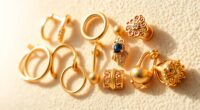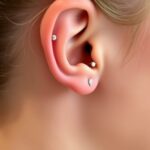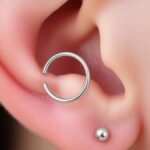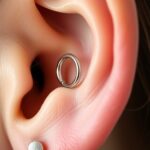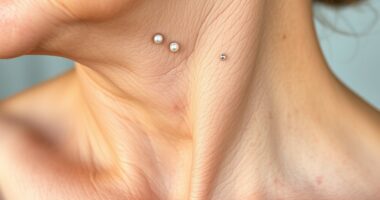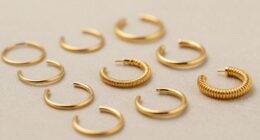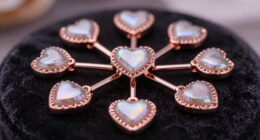As you shift from athletic to office life, focus on keeping your piercings comfortable and discreet. During healing, avoid removing jewelry unless advised by a professional, and opt for lightweight, smooth pieces that won’t snag or irritate your skin. When your piercings are healed, switch to subtle, professional jewelry like studs or hoops. Staying attentive to hygiene and jewelry fit will help you maintain healthy piercings. Discover more tips for a smooth progression and long-lasting piercings.
Key Takeaways
- Keep piercings clean and avoid removing jewelry during healing unless approved by a professional.
- Choose lightweight, smooth jewelry suitable for active routines and office wear.
- Transition to subtle, professional jewelry like studs or small hoops after healing.
- Consult your piercer before changing jewelry during healing to prevent complications.
- Prioritize proper hygiene and gentle handling to maintain piercing health during lifestyle changes.

Managing lifestyle changes can be challenging, especially when you have piercings. Transitioning from an active, athletic routine to a more professional, office-based environment requires careful planning, especially if you want to keep your piercings intact and looking their best. The key is understanding how your piercing jewelry interacts with your daily activities and how the healing process influences your choices.
Managing piercings during lifestyle changes requires thoughtful care and patience for healthy, stylish results.
When you’re an athlete, your piercing jewelry often needs to withstand sweat, movement, and sometimes even rough contact. As you shift to an office setting, you might consider switching to more subtle or less conspicuous jewelry. However, if your piercings are still healing, you need to prioritize the healing process to prevent complications. During this period, it’s vital to avoid removing jewelry unless instructed by a professional, as unnecessary removal can cause scarring or prolong healing. If you must change your jewelry for comfort or aesthetic reasons, consult your piercer first to ensure it’s safe to do so.
The healing process varies based on the piercing’s location and your body’s response, but generally, it takes several months. During this time, the piercing is especially vulnerable to irritation or infection, which can be exacerbated by daily activities or changes in routine. As you shift to office life, be mindful of how your jewelry fits and feels. Tight or heavy jewelry might cause discomfort under a collared shirt or during long hours at a desk. Opt for lightweight, smooth pieces that won’t snag or irritate your skin. Also, keep your piercing clean and dry, especially if you’re changing environments or handling different materials, to avoid introducing bacteria that could hinder healing.
Additionally, understanding the importance of contrast ratio can help you choose jewelry that complements your environment, ensuring your piercings and accessories look their best in various lighting conditions. If you’re considering removing or changing your jewelry during this transition, do so only after your piercer confirms your piercing has healed sufficiently. This helps prevent unnecessary trauma to the tissue. Once healed, you’ll have more flexibility to switch to professional-appropriate piercing jewelry, like subtle studs or hoops that complement your office attire. Remember, maintaining good hygiene and avoiding unnecessary manipulation of your jewelry during the healing process are vital steps to keep your piercings healthy and looking great.
Ultimately, managing piercings through lifestyle transitions means balancing your personal style with the needs of your healing piercing. Patience and proper care ensure your jewelry stays safe and your piercing remains healthy. Adapting your jewelry choices as you settle into your new routine helps you feel confident and comfortable every step of the way.
Frequently Asked Questions
How Long Should I Wait Before Changing Workplace Piercing Policies?
You should wait at least six months before changing workplace piercing policies. This allows enough time for healing and guarantees piercings are secure, reducing the risk of complications. When updating policies, consider your workplace dress code and piercing regulations to create a safe, inclusive environment. Clear communication helps staff understand any new rules, making shifts smoother. Prioritize health and professionalism to maintain a positive work atmosphere.
Are There Specific Types of Piercings More Acceptable in Office Settings?
They say, “First impressions matter,” and studying office norms helps you decide which piercings are more acceptable. When evaluating piercing types, opt for subtle, professional choices like small studs or hoops instead of large, dangling jewelry. These tend to blend better in formal settings. Remember, choosing the right piercing shows respect for your workplace culture while allowing you to express your personality thoughtfully.
How Can I Discreetly Cover Piercings During Professional Meetings?
To discreetly cover piercings during professional meetings, you can use discreet jewelry or piercing covers. Choose clear or skin-toned jewelry that blends with your skin tone, or opt for specialized covers designed to conceal piercings easily. These solutions help maintain a professional appearance without drawing attention. When you need to be subtle, these options allow you to manage your piercings confidently and comfortably during important meetings or presentations.
What Are the Best Aftercare Tips for New Piercings During Transitions?
Ever wonder how to keep your new piercing healthy during a busy change? Prioritize piercing hygiene by cleaning it gently twice daily with saline solution. Avoid touching the area with unwashed hands, and steer clear of irritating products. Choose jewelry that’s safe and appropriate for healing, avoiding tight or allergenic pieces. These tips help prevent infection and promote faster healing, ensuring your piercing stays in great condition through every lifestyle change.
Can Professional Environments Impact Healing Times for Piercings?
Workplace restrictions and healing environments can definitely impact your piercing healing times. In a professional setting, strict policies or limited flexibility might delay proper aftercare or cause you to hide your piercings, which can slow healing. To guarantee faster recovery, try to create a comfortable healing environment at work, follow your piercer’s advice, and communicate with your employer if needed. This helps avoid complications and promotes quicker healing.
Conclusion
As you navigate lifestyle changes, managing piercings is like tending a garden—you need patience and care to make certain they flourish. Whether you’re shifting from athlete to office worker or vice versa, staying attentive to your piercings helps prevent complications and keeps your style on point. Embrace the process with confidence, knowing that with proper care, your piercings can adapt beautifully to your new chapter—like a chameleon blending seamlessly into its surroundings.


